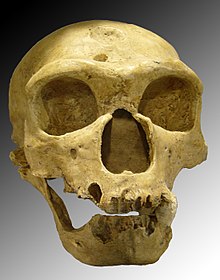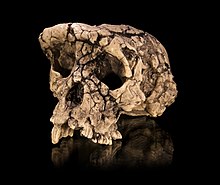User:Cesiumfrog/Hominoid taxonomy
| It has been suggested that Hominidae and History of hominoid taxonomy be merged into this page. (Discuss) |
| It has been suggested that this page be merged with Human taxonomy. (Discuss) |



Taxonomy (current)[edit]
The current taxonomy for all species of apes is:
| Hominoidea |
| ||||||||||||||||||||||||||||||||||||||||||||||||||||||||||||||||||
Terminology[edit]
Clades which include humans[edit]
A major focus of hominoid taxonomy is the evolutionary history of humans, and hence on clades which contain Homo sapiens.
Hominina[edit]
In the taxonomic classification of primates Hominina is sometimes used to describe a subtribe of the tribe Hominini which includes only the genus Homo. Hominini in turn includes the australopithecines and earlier upright walking primates such as Orrorin tugenensis, Ardipithecus and Sahelanthropus.[1] Members are known as hominans or hominas
Hominini[edit]
Hominini is the tribe of Homininae that comprises Homo, and other members of the human clade after the split from the tribe Panini (chimpanzees).[2][1] Members of the tribe are called hominins (cf. Hominidae, "hominids"). The subtribe Hominina is the "human" branch, including genus Homo. Researchers proposed the taxon Hominini on the basis of the idea that the least similar species of a trichotomy should be separated from the other two. Some earlier classification schemes include the genus Pan (chimpanzees) within the Hominini, but this classification is now rarely followed.
Through DNA comparison, scientists believe the Pan/Homo divergence occurred between 5.4 and 6.3 million years ago, after an unusual process of speciation that ranged over 4 million years.[3] Few fossil specimens on the Pan side of the split have been found, the first fossil chimpanzee discovery being published in 2005,[4] dating to between 545 ± 3 kyr (thousand years) and 284 ± 12 kyr via Argon-argon dating, from Kenya's East African Rift Valley. All of the extinct genera listed in the table to the right are ancestral to Homo, or are offshoots of such. However, both Orrorin and Sahelanthropus existed around the time of the split, and so may be ancestral to all three extant species.
In the proposal of Mann and Weiss (1996),[5] the tribe Hominini includes Pan as well as Homo, but within separate subtribes. Homo (and, by inference, all bipedal apes) is in the subtribe Hominina, while Pan is in the subtribe Panina. Wood (2010) discusses the different views of this taxonomy.[6]
Homininae[edit]
Homininae is a subfamily of Hominidae that includes humans, gorillas, chimpanzees, and some extinct relatives; it comprises all hominids that arose after the split from orangutans (Ponginae). Roughly, it is the African great apes. The Homininae cladogram has three main branches, which lead to gorillas, chimpanzees, and humans. There are several extant species of chimpanzees and gorillas, but only one human species remains, although several sub-species of Homo sapiens still existed 30,000 years ago. Organisms in this class are described as hominine or hominines.
Hominidae[edit]
The great apes, that is, orangutans, gorillas, chimpanzees and humans.
Hominoidea[edit]
Apes (gibbons and the great apes) including humans.
History of classification[edit]
Until 1980, the family Hominidae contained only humans, with the great apes in the family Pongidae.[7] Later discoveries led to a revision of classification, with Hominidae uniting the great apes (now in the sub-family Ponginae) and humans (in the sub-family Homininae).[8] Further discoveries indicated that gorillas and chimpanzees are more closely related to humans than they are to orangutans, leading to their current placement in Homininae as well.[9]
The subfamily Homininae can be further subdivided into three tribes, each with only a single living genus: Gorillini (gorillas), Panini (chimpanzees), and Hominini (humans and their extinct relatives). The early Late Miocene Nakalipithecus nakayamai, described in 2007, and perhaps also its contemporary Ouranopithecus, are basal members of this clade, not assignable to any of the three extant tribes. They suggest that the Homininae tribes diverged not earlier than about 8 million years ago (see Human evolutionary genetics).
Today, chimpanzees and gorillas live in tropical forests with acid soils that rarely preserved as fossils. No fossil chimpanzees or gorillas have been reported. However, four chimpanzee teeth, about 500,000 years old, have recently been discovered in the rift valley,[clarification needed] where many fossils from the human lineage (hominins)[Note 1] have previously been found.[contradictory][10] This shows that some chimpanzees lived close to Homo (H. erectus or H. rhodesiensis) at the time; the same is likely true for gorillas.
Evolution[edit]
| It has been suggested that this page be merged into Human evolution. (Discuss) |
Evolution of bipedalism[edit]
Recent studies of Ardipithecus ramidus (4.4 million years old) and Orrorin tugenensis (6 million years old) suggest some degree of bipedalism. Australopithecus and early Paranthropus may have been bipedal. Very early hominins such as Ardipithecus ramidus may have possessed an arboreal type of bipedalism.[11] and towards efficient walking and running in modern humans.
Brain size evolution[edit]
There has been a gradual increase in brain volume (brain size) as the ancestors of modern humans progressed along the timeline of human evolution, starting from about 600 cm3 in Homo habilis up to 1500 cm3 in Homo sapiens neanderthalensis. However, modern Homo sapiens have a brain volume slightly smaller (1250 cm3) than Neanderthals, women have a brain slightly smaller than men and the Flores hominids (Homo floresiensis), nicknamed hobbits, had a cranial capacity of about 380 cm3 (considered small for a chimpanzee), about a third of the Homo erectus average. It is proposed that they evolved from H. erectus as a case of insular dwarfism.[citation needed] In spite of their smaller brain, there is evidence that H. floresiensis used fire and made stone tools at least as sophisticated as those of their proposed ancestors H. erectus.[12] In this case, it seems that for intelligence, the structure of the brain is more important than its size.[13]
Evolution of family structure and sexuality[edit]
Sexuality is related to family structure and partly shapes it. The involvement of fathers in education is quite unique to humans, at least when compared to other Homininae. Concealed ovulation and menopause in women both also occur in a few other primates however, but are uncommon in other species. Testis and penis size seems to be related to family structure: monogamy or promiscuity, or harem, in humans, chimpanzees or gorillas, respectively.[14][15] The levels of sexual dimorphism are generally seen as a marker of sexual selection. Studies have suggested that the earliest hominins were dimorphic and that this lessened over the course of the evolution of the genus Homo, correlating with humans becoming more monogamous, whereas gorillas, who live in harems, show a large degree of sexual dimorphism. Concealed (or "hidden") ovulation means that the phase of fertility is not detectable in women, whereas chimpanzees advertise ovulation via an obvious swelling of the genitals. Women can be partly aware of their ovulation along the menstrual phases, but men are essentially unable to detect ovulation in women. Most primates have semi-concealed ovulation, thus one can think that the common ancestor had semi-concealed ovulation, that was inherited by gorillas, and that later evolved in concealed ovulation in humans and advertised ovulation in chimpanzees. Menopause also occurs in rhesus monkeys, and possibly in chimpanzees, but does not in gorillas and is quite uncommon in other primates (and other mammal groups).[15]
See also[edit]
References[edit]
- ^ A hominin is a member of the tribe Hominini, a hominine is a member of the subfamily Homininae, a hominid is a member of the family Hominidae, and a hominoid is a member of the superfamily Hominoidea.
- ^ a b Wood and Richmond.; Richmond, BG (2000). "Human evolution: taxonomy and paleobiology". Journal of Anatomy. 197: 19–60. doi:10.1046/j.1469-7580.2000.19710019.x. PMC 1468107. PMID 10999270.
- ^ Bradley, B.J. (2006). "Reconstructing Phylogenies and Phenotypes: A Molecular View of Human Evolution". Journal of Anatomy. 212 (4): 337–353. doi:10.1111/j.1469-7580.2007.00840.x.
- ^ "Human and chimp genomes reveal new twist on origin of species". [ EurekAlert!/AAAS]. 2006-05-17.
{{cite web}}:|access-date=requires|url=(help); Missing or empty|url=(help) - ^ McBrearty, Sally and Nina G. Jablonski (2005). "First fossil chimpanzee". Nature. 437 (7055): 105–108. Bibcode:2005Natur.437..105M. doi:10.1038/nature04008. PMID 16136135.
- ^ Mann, Alan and Mark Weiss (1996). "Hominoid Phylogeny and Taxonomy: a consideration of the molecular and Fossil Evidence in an Historical Perspective". Molecular Phylogenetics and Evolution. 5 (1): 169–181. doi:10.1006/mpev.1996.0011. PMID 8673284.
- ^ B. Wood (2010). "Reconstructing human evolution: Achievements, challenges, and opportunities". Proceedings of the National Academy of Sciences. 107: 8902–8909. Bibcode:2010PNAS..107.8902W. doi:10.1073/pnas.1001649107.
- ^ M. Goodman (1964). "Man's place in the phylogeny of the primates as reflected in serum proteins". In S. L. Washburn (ed.). Classification and human evolution. Aldine, Chicago. pp. 204–234.
- ^ M. Goodman (1974). "Biochemical Evidence on Hominid Phylogeny". Annual Review of Anthropology. 3: 203–228. doi:10.1146/annurev.an.03.100174.001223.
- ^ M. Goodman, D. A. Tagle, D. H. Fitch, W. Bailey, J. Czelusniak, B. F. Koop, P. Benson, J. L. Slightom (1990). "Primate evolution at the DNA level and a classification of hominoids". Journal of Molecular Evolution. 30 (3): 260–266. doi:10.1007/BF02099995. PMID 2109087.
{{cite journal}}: CS1 maint: multiple names: authors list (link) - ^ McBrearty and Jablonski, Nature, 2005
- ^ Kivell TL, Schmitt D 2009 Independent evolution of knuckle-walking in African apes shows that humans did not evolve from a knuckle-walking ancestor. Proc Natl Acad Sci U S A. 2009 Aug 25;106(34):14241-6. PMID 19667206
- ^ Brown P, Sutikna T, Morwood MJ; et al. (2004). "A new small-bodied hominin from the Late Pleistocene of Flores, Indonesia". Nature. 431 (7012): 1055–61. doi:10.1038/nature02999. PMID 15514638.
{{cite journal}}: Explicit use of et al. in:|author=(help)CS1 maint: multiple names: authors list (link) - ^ Davidson, Iain. "As large as you need and as small as you can'--implications of the brain size of Homo floresiensis, (Iain Davidson)". Une-au.academia.edu. Retrieved 2011-10-30.
- ^ Diamond, Jared. The Third Chimpanzee.
- ^ a b Diamond, Jared. Why is Sex Fun?.
- "Human Evolutionary Genetics" Jobling M.A., Hurles M., Tyler Smith C. 2004, Garland Science, New York
